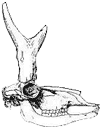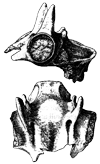Antelope

Skull of Antilocapra americana
Perhaps no other group of mammals can be considered as more quintessentially North American than our pronghorn antelope. Although popularly called antelopes, pronghorns are more properly termed antilocaprids. They are not closely related to the true antelopes of the Old World which are close relatives of cows, sheep and goats. The antilocaprids are known only from North America and unlike many other groups that originated here such as the horses and camels, the antilocaprids never dispersed from their continent of origin.
Although there is only a single living representative of the group today, Antilocapra americana, the pronghorns were a diverse group in the past. Antilocaprids first appear in the middle Miocene and have been a common member of the North American fauna ever since. North American antilocaprids have prominent horns which superficially look like those of the bovids or cow family which also includes sheep, goats and African antelopes. Like these other animals there is a bony core which projects from the top of the skull covered with an outer covering of horn. The major difference is that in antilocaprids this outer covering of horn is shed each year and regrown while in the bovids the outer horn continually grows throughout the life of the animal and is never shed. As with members of the cow family, the horns are present in males and females and like the cows they are generally larger and better developed in males than in females.
Another feature of some fossil antilocaprids that distinguishes them from bovids is that the pronghorn might be divided so that in some forms there was a pair of horns on each side of the skull and in others three horns. This certainly makes it easy to tell the different types of pronghorns apart. While the living pronghorn lacks any branches to the bony core of the horn, they may have been present in its ancestors since the outer covering of horn has a branch on its front side.
During the excavation at the Horse Quarry by the Smithsonian Institution, the remains of two individuals of a small antelope were found. One set of remains was from an adult and another from a juvenile. Unfortunately neither were complete skeletons. The adult consisted of the back part of the skull and the first five neck vertebrae and the juvenile an immature skull and hind leg. The adult skull preserved the horn cores and showed that like many other fossil antilocaprids this animal had two horns. The larger of the two horns was in front and positioned directly above the eye and the smaller one sat just behind it. In other antilocaprids the front horn often tilted forward and the back horns tilted backwards but in the Hagerman specimen both horn cores stick straight up from the skull.

Side and top view of antilocapra skull.
Because of the distinctive differences in the horn and other features of the skull, C.L. Gazin in 1935, described this new antilocaprid as Ceratomeryx prenticei. Cerato is Greek for horn and meryx is a Greek word used for ruminants, a group of mammals that includes cows, bison, African antelopes and their relatives. The species name is for Sidney Prentice, a scientific illustrator at the Smithsonian and also the illustrator for the paper in which the new animal was described.
Ceratomeryx was a small animal about half the size of the living pronghorn. The living North American pronghorn is well adapted to open grassland habitat and is a fast runner, having been clocked at 86.5 km/hour (54 miles/hour). Byers (1998) suggested that the speed of the living pronghorn evolved to escape fast predators such as the extinct North American cheetah. While Ceratomeryx may not have been as fast as its living relative, its primary defense to escape predators probably also involved running since its smaller size would have made it vulnerable to a wide variety of predators. Another indication of its mobility is the preserved leg bones which are similar to those in its living relative.
Ceratomeryx is not a common member of the Hagerman fauna. Since its initial discovery only a few additional isolated teeth and bones have been found. In addition to its rarity at Hagerman it has not yet been found any place else. Since it is known from such a small number of specimens it simply may have gone unrecognized in other faunas. The lack of material makes it difficult to say much about the animal, but it probably shared the grassland habitats with the Hagerman Horse.